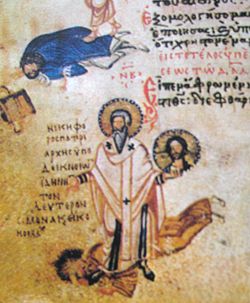Top Qs
Timeline
Chat
Perspective
March 13 (Eastern Orthodox liturgics)
From Wikipedia, the free encyclopedia
Remove ads
March 12 - Eastern Orthodox liturgical calendar - March 14

All fixed commemorations below are observed on March 26 by Eastern Orthodox Churches on the Old Calendar.[note 1]
For March 13th, Orthodox Churches on the Old Calendar commemorate the Saints listed on February 28 (February 29 on leap years).
Saints
- Hieromartyr Publius, Bishop of Malta and later Bishop of Athens (2nd century)[1][2][note 2] (see also: January 21 - West)
- Martyrs Alexander,[1][4] Dionysius and Frontonus, the "Basilikoi" (the Emperor's men), in Thessaloniki (c. 305)[5] (see also: March 14)
- Martyr Christina of Persia, scourged to death (4th century)[1][6][7]
- Venerable Euphrasia, in the Thebaid (Thebais).[8][9][10] (see also: July 25)
- Martyr Abibus (Sabinus), at Hermopolis in Egypt, tied with stones and drowned in a river.[9][11][12]
- Saint Marios (Marius), Bishop of Sebasteia.[12][13]
- Venerable martyr Theoktistos, of the Great Lavra of St. Sabbas the Sanctified, reposed in peace (797)[14]
Remove ads
Pre-Schism Western saints
- Martyrs Africanus, Publius, and Terence, at Carthage (250)[1][15][note 3]
- Saint Leander of Seville, Bishop of Seville (596)[1][17]
- Martyr Ramirus and Companions, at the monastery of St Claudio in Leon in Spain (c. 554 or 630)[18][note 4]
- Saint Mochoemoc (Mochaemhog, Pulcherius, Vulcanius), monk at Bangor in Co. Down under St Comgall, later founded Liath-Mochoemoc (c. 656)[18][19][20][note 5]
- Saint Kevoca (Kennotha, Quivoca), a saint honoured in Kyle in Scotland (7th century)[18][21]
- Saint Gerald of Mayo, followed St Colman from Lindisfarne to Ireland and became his successor in the English monastery in Mayo (732)[18][22]
- Saint Ansovinus, Bishop of Camerino (840)[9][18][23][note 6]
- Saint Heldrad (Eldrad, Eldradus), abbot at Novalesa Abbey for thirty years (842)[18]
- Martyrs Rudericus (Roderick) and Salomon (Solomon), in Córdoba in Spain (857)[9][18][24][note 7]
Remove ads
Post-Schism Orthodox saints
New martyrs and confessors
Other commemorations
- Translation of the relics (846) of St. Nicephorus the Confessor, Patriarch of Constantinople (829)[1][28][29][30]
- Repose of Elder Ephraim of Valaam Monastery (1946)[1]
- Repose of Bishop Tikhon (Tikhomirov) of Kyrillov (1955)[1][note 9]
Icon gallery
- St. Leander of Seville.
- St. Nicephorus the Confessor trampling on the iconoclast Emperor John VII Grammatikos.
Notes
- The notation Old Style or (OS) is sometimes used to indicate a date in the Julian Calendar (which is used by churches on the "Old Calendar").
The notation New Style or (NS), indicates a date in the Revised Julian calendar (which is used by churches on the "New Calendar"). - In the Eastern Orthodox Church his feast day is observed on March 13. According to an epistle of Saint Dionysius, Bishop of Corinth, Saint Publius lived in the 2nd century and came from the city of Athens. He became bishop there as the successor of Saint Narcissus of Athens, thus dating his martyrdom to the period of the persecution under Marcus Aurelius (161-180).[2]
However, in the West (Roman Catholic Church), his feast day is celebrated instead on January 21, and he is placed as the successor of St. Dionysius the Areopagite (Denis the Areopagite), dating his martyrdom to c. 112 AD:- "At Athens, the birthday of St. Publius, bishop, who, as successor of St. Denis the Areopagite, nobly governed the Church of Athens. No less celebrated for the lustre of his virtues than for the brilliancy of his learning, he was gloriously crowned for having borne testimony to Christ."[3]
- The Holy Martyrs Africanus, Publius and Terence suffered in the 3rd century at Petrium. Their memory is celebrated also on October 28, April 5 and April 10.[16]
- A monk at the monastery of St Claudio in Leon in Spain. Two days after the abbot, St Vincent, was martyred, Ramirus and all the other monks were martyred by the Arian Visigoths while they sang the Creed.
- Born in Camerino in Italy, after living as a hermit at Castel Raimondo near Torcello, he became bishop of his native town. He accepted the office on condition that his see should be exempt from the service of recruiting soldiers, then imposed on most bishops.
- Roderick was a priest in Cabra near Cordoba in Spain who was betrayed by his Muslim brother and imprisoned there. In prison he met his fellow-martyr, Salomon. They were both martyred in Cordoba.
- See: (in Russian) Стефан (Бех). Википедии. Russian Wikipedia.
- See: (in Russian) Тихон (Тихомиров). Википедии. Russian Wikipedia.
Remove ads
References
Sources
Wikiwand - on
Seamless Wikipedia browsing. On steroids.
Remove ads



